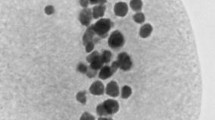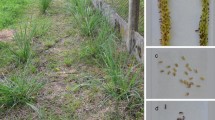Abstract
A successful interspecific hybridization between cucumber (Cucumis sativus L., 2n = 14) and a wild it Cucumis species, C. hystrix Chakr. (2n = 24) was made via embryo rescue. Hybrid plants (2n = 19; 7 from cucumber and 12 from C. hystrix) were sterile, but morphologically uniform. Self-pollination and backcrossing of F1 hybrid plants to either parent confirmed presence of both male- and female-sterility that were likely caused by lack of homology and improper pairing during meiosis. While the multiple-branching habit, densely brown hairs (on corolla and pistil), orange-yellow corolla, and ovate fruit of F1 hybrid plants were similar to that of the C. hystrix parent, the appearance of the first pistillate flower was more similar to that of C. sativus parent. The diameter and internode length of the stem, and the shape and size of leaves and flowers were intermediate when compared to the parents. The chromosome number in the hybrid was doubled through somaclonal variation during embryo culture and regeneration process to restore the fertility. Pollen grains were released and fruits with viable seeds matured on fertile, synthetic amphidiploid plants. The results from flow cytometry indicated that, on average, 7.3% of the morphologically unique regenerants had the 4C DNA content of 2.35 pg relative to the 2C DNA content of the original F1 hybrid at 1.17 pg and, therefore, were likely chromosome-doubled F1 hybrids (2n = 38). Nutrition alanalysis indicated that the synthetic species had higher protein (0.78%)and mineral (0.35%) content compared to the normal pickling cucumber(0.62% and 0.27%, respectively), and could be considered a new Cucumis crop having a special place in the future agriculture. Preliminarily evaluation indicates that C. hystrix possesses a high level of root-knot nematode resistance, and that this resistance is partially expressed in the interspecific F1 and chromosome-doubled F1. This and the fact that the fruit morphology of the fertile amphidiploid differs during the growing season (e.g., short and long fruit) suggest that it could be useful in broadening the germplasm base of cucumber.
Similar content being viewed by others
References
Batra, S., 1953. Interspecific hybridization in the genus Cucumis. Sci. Culture 18: 445–446.
Chen, J.F., S.L. Zhang & X.G. Zhang, 1994. The xishuangbanna gourd (C. sativus var. xishuangbannesis Qi et Yuan), a traditionally cultivated plant of the Hanai people, Xishuangbanna, Yunnan, China. Cucurbit Genet Coop Rpt 17: 18–20.
Chen, J.F., J.E. Staub, Y. Tashiro, S. Isshiki & S. Miyazaki, 1997. Successful interspecific hybridization between Cucumis sativus L. and C. hystrix Chakr. Euphytica 96: 413–419.
Deakin, J.R., G.W. Bohn & T.W. Whitaker, 1971. Interspecific hybridization in Cucumis. Econ Bot 25: 195–211.
Fassuliotis, G., 1967. Species of Cucumis resistant to the rootknot nematode, Meloidogyne incognita acrita. Plant Dis Rpt 51: 720–723.
Hussey, R.S. & K.R. Barker, 1973. A comparison of methods of collecting inocula of Meloidogyne spp. including a new technique. Plant Dis Rpt 57: 1025–1028.
Norton, J.D. & D.M. Granberry, 1980. Characteristics of progeny from an interspecific cross of Cucumis melo with C. metuliferus. J Amer Soc Hort Sci 105: 174–180.
Pearson, O.H., R. Hopp & G.W. Bohn, 1951. Notes on species crosses in Cucurbita. Proc Am Soc Hort Sci 57: 310.
Smith, P.G. & B.R. Benkat Ram, 1954. Interspecific hybridization between muskmelon and cucumber. J Hered 45: 24.
Stalker, H.T., 1980. Utilization of wild species for crop improvement. In: N.C. Brady (Ed.), Advances in Agronomy, vol. 33: 111–147.
Walters, S.A., T.C. Wehner & K.R. Barker, 1993. Root-knot nematode resistance in cucumber and horned cucumber. HortScience 28: 151–154.
Whitaker, T.W., 1930. Chromosome number in cultivated cucurbits. Am J Bot 17: 1033–1040.
Yadava, K.S., A.K. Singh, R.P. Roy & U.C. Jha, 1986. Cytogenetics in Cucumis L. VI, synthetic amphidiploids. Nucleus 29: 58–62.
Author information
Authors and Affiliations
Rights and permissions
About this article
Cite this article
Chen, JF., Staub, J., Adelberg, J. et al. Synthesis and preliminary characterization of a new species (amphidiploid) in Cucumis . Euphytica 123, 315–322 (2002). https://doi.org/10.1023/A:1015095430624
Issue Date:
DOI: https://doi.org/10.1023/A:1015095430624




